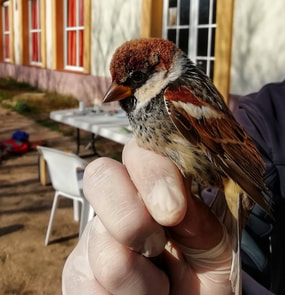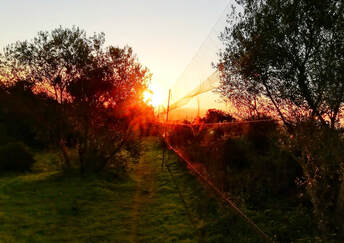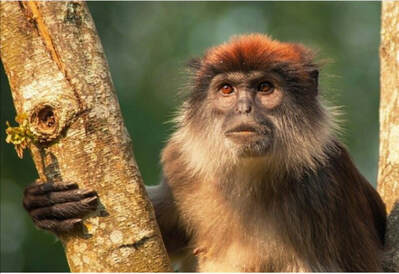Host-Pathogen interactions
I use a combination of genomics and transcriptomics to better understand disease susceptibility, host response to infection and host-parasite interactions. I currently lead two projects funded by European Union programs.
I use a combination of genomics and transcriptomics to better understand disease susceptibility, host response to infection and host-parasite interactions. I currently lead two projects funded by European Union programs.

Understanding the genetic basis of susceptibility to West Nile Virus in birds. TransWNV
Emerging infectious diseases that have a wildlife reservoir pose a major challenge to global health. This is the case for West Nile Virus (WNV), which is the number one causative agent of viral encephalitis worldwide. Although it infects humans, the
main hosts of WNV are birds. Thus, to develop effective intervention strategies it is critical to understand the disease dynamics in birds. In WNV, disease dynamics are
influenced by variation in disease susceptibility across individuals and species, but the factors underlying this variation are poorly understood. To further understand disease susceptibility we will use genomic tools to identify candidate genes and pathways that will allow us to gain insights into the avian immune response to the virus and uncover the genetic basis of susceptibility both at the species and individual level. This work will be carried out in collaboration with the INIA, and is supported by the European Union through the Marie Curie program H2020-MSCA-IF-2017.
Emerging infectious diseases that have a wildlife reservoir pose a major challenge to global health. This is the case for West Nile Virus (WNV), which is the number one causative agent of viral encephalitis worldwide. Although it infects humans, the
main hosts of WNV are birds. Thus, to develop effective intervention strategies it is critical to understand the disease dynamics in birds. In WNV, disease dynamics are
influenced by variation in disease susceptibility across individuals and species, but the factors underlying this variation are poorly understood. To further understand disease susceptibility we will use genomic tools to identify candidate genes and pathways that will allow us to gain insights into the avian immune response to the virus and uncover the genetic basis of susceptibility both at the species and individual level. This work will be carried out in collaboration with the INIA, and is supported by the European Union through the Marie Curie program H2020-MSCA-IF-2017.

Single parasite transcriptomes and gene copy number variation of two different species of avian malaria with different virulence. SINCAMA
In collaboration with the Genomics Core Leuven (Katholieke Universiteit Leuven) and as part of the consortium EASI GENOMICS we are using a combination of genomics, transcriptomics and single-cell sequencing to build the genomes and transcriptomes of different lineages of two species of avian malaria (Plasmodium relictum and Plasmodium cathemerium) which have different virulence. These genomic resources will allow us to understand better host-parasite interactions and differences in virulence.
In collaboration with the Genomics Core Leuven (Katholieke Universiteit Leuven) and as part of the consortium EASI GENOMICS we are using a combination of genomics, transcriptomics and single-cell sequencing to build the genomes and transcriptomes of different lineages of two species of avian malaria (Plasmodium relictum and Plasmodium cathemerium) which have different virulence. These genomic resources will allow us to understand better host-parasite interactions and differences in virulence.
Conservation genetics
Over the years much of my work has involved the use of genetic and genomic data to aid in the conservation of endangered species. In general I am interested in understanding how abiotic and biotic factors, including anthropogenic impacts, shape genetic diversity and structure at the population level and how these are ultimately related to disease susceptibility and population viability in small and endangered populations. Such information can then be used to inform conservation decisions and aid in the designation of conservation priorities.
Over the years much of my work has involved the use of genetic and genomic data to aid in the conservation of endangered species. In general I am interested in understanding how abiotic and biotic factors, including anthropogenic impacts, shape genetic diversity and structure at the population level and how these are ultimately related to disease susceptibility and population viability in small and endangered populations. Such information can then be used to inform conservation decisions and aid in the designation of conservation priorities.

Effects of habitat fragmentation on Red Colobus in Uganda
I collaborate with the Molecular Anthropology group (University of Oregon) and the Kibale Ecohealth project to understand the effects of habitat fragmentation on primate population size, migration patterns and relatedness. The ultimate goal of the project is to discover how anthropogenic changes to ecosystems alter health-related outcomes and infectious disease dynamics in people, wildlife, and domestic animals.
I collaborate with the Molecular Anthropology group (University of Oregon) and the Kibale Ecohealth project to understand the effects of habitat fragmentation on primate population size, migration patterns and relatedness. The ultimate goal of the project is to discover how anthropogenic changes to ecosystems alter health-related outcomes and infectious disease dynamics in people, wildlife, and domestic animals.
